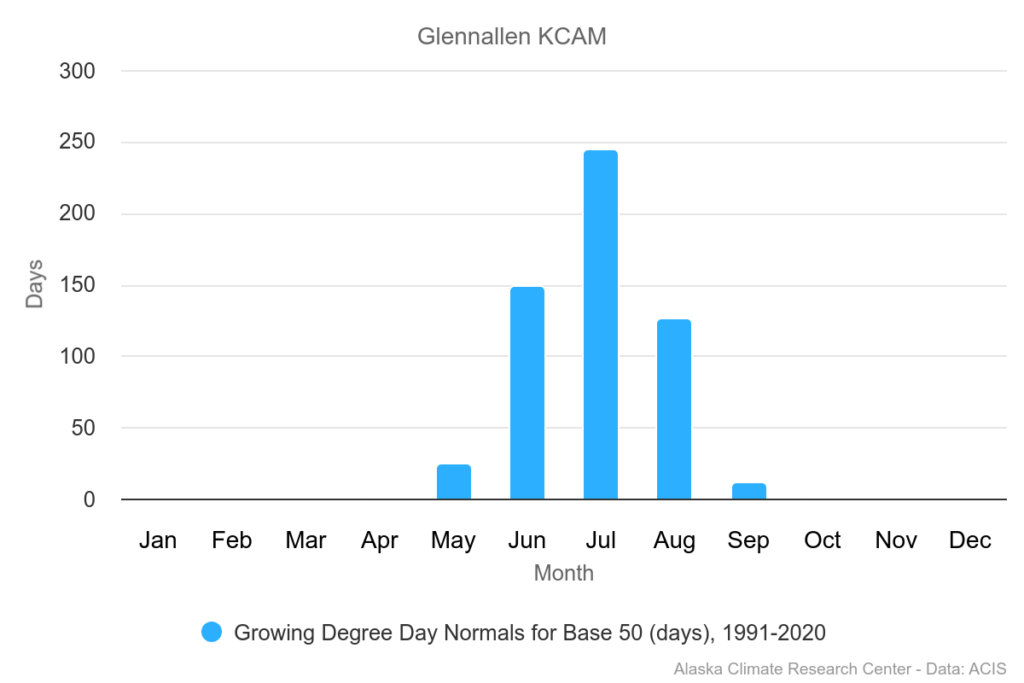Growing Degree Days (GDDs)
Adapted for Alaska from Cornell’s Agronomy Fact Sheet #112
Intro
Temperature influences the development of many crops, weeds, and insects through many stages such as insect pest emergence, weed seedling emergence, and field crop fruit set. Tracking seasonal heat accumulation can calculate and predict these events (Figures 1). Growing Degree Days (GDDs) measures the accumulation of heat units over a day or multiple days in the season. Tracking growing degree days can be more accurate than following calendar days to forecast crop harvests, insect emergence, as well as predicting when to fertilize long-term field crops because weather can be highly variable each year.

Figure 1: Growing Degree Day Normals refer to current conditions being “warmer than normal” (or colder, or wetter, or drier, or…), we compare current conditions to averages over a 30 year climatological reference period, i.e. the statistical normal. The most recent reference period is 1991-2020.Calculating Growing Degree Days
Heat Unit (Growing Degree Days) accumulation per day is calculated by subtracting the base temperature threshold from the average daily temperature. The base temperature threshold is the temperature below which no plant or insect development occurs for specific crops.

Equation 1: Growing degree day calculation for a day is based on minimum and maximum daily temperature compared to a base temperature that is species specific.The base temperature will vary between crops, especially for cold and warm weather crops. For example, alfalfa is adapted to cooler weather and has a base temperature of 41℉. In contrast, corn, soybeans, and sorghum all have base temperatures of 50℉. The same is true for crop pests. Kale aphids have a base temperature threshold of 50℉ while the base temperature threshold for whiteflies is 59℉.
For many plants and insects, there is no upper threshold that can be applied, but some other species cannot develop properly if the threshold reaches a certain limit. For example, spinach germination greatly decreases after air temperature reaches 75℉ and the heat can also cause the plants to go to seed.
If the average daily temperature is below the base temperature this means no heat units will be accumulated for that day (GDD=0). If the average daily temperature is above the maximum daily temperature threshold for the crop species the daily max temperature is set at the maximum temperature threshold. See Box 2 and 3 below for examples of corn.

Equation 2: If the daily low is 44℉, and the daily high is 74℉, the daily GDD accumulation for corn is 9
Equation 3: If the daily low is 54℉ and the daily high is 94℉, the daily GDD accumulation for corn is 20
Cumulative Growing Degree Days
To calculate the sum of growing degree days for a season or the year, add the values for multiple, consecutive days. Syngenta has developed a GDD calculator where the user can select a location on the map and a base temperature threshold to receive the cumulative GDDs for the season to date.
Use of Growing Degree Days in Agriculture
Predict Harvest Dates
GDDs can be used to predict crop harvest dates as crops will reach certain developmental stages after a certain amount of growing degree days. The number of GDDs required for particular crops can also be affected by certain stressors the crop faces throughout the season like drought, insect damage, or excessively wet conditions. This means GDDs measurements are only an approximation and field sampling is still required for optimal accuracy.
Insect, Weed, and Disease
Insect pests are more vulnerable to control measures when in certain developmental life stages (egg hatch, larva, pupa, adult, etc.) For example, the egg hatch stage (the best management stage for the coming generation) of the alfalfa weevil takes place 280 GDD (base 50℉) after adults are observed in the spring.
Nutrient Management
As some crops reach certain developmental stages they will benefit from additional fertilization. For example, tomatoes will benefit from a second application of nitrogen, calcium, and magnesium before the fruit set stage. Using GDD to track this developmental stage of the crop allows the farmer to fertilize before the fruit begins to set.
Written by Garrett Richards, agAlaska Soil Tech


Comments are closed